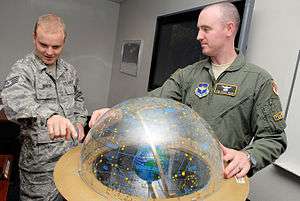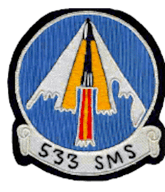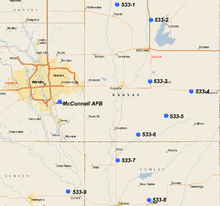533d Training Squadron
533d Training Squadron
 | |
|---|---|
 A 533rd Training Squadron student shows an instructor a point used to see the apparent path the sun takes through the stars | |
| Active | 1942-1945; 1962-1986; 1994-present |
| Country |
|
| Branch |
|
| Type | Squadron |
| Role | Satellite control and missile warning training |
| Part of | Air Education and Training Command |
| Garrison/HQ | Vandenberg Air Force Base, California |
| Engagements | European Theater of Operations[1] |
| Decorations |
Distinguished Unit Citation[1] Air Force Outstanding Unit Award |
| Insignia | |
| 533d Training Squadron emblem (approved 4 September 1943)[1] |
|
| Patch with 533d Strategic Missile Squadron emblem |
 |
The 533d Training Squadron is a United States Air Force unit. It is assigned to the 381st Training Group at Vandenberg Air Force Base, California, where it trains airmen on space systems. It was activated in this role in 1994.
The squadron was first activated in 1942 as the 533d Bombardment Squadron. It moved to England in 1943 and served in combat until 1945, earning two Distinguished Unit Citations for its actions in combat. Following V-E Day, the squadron returned to the United States, where it was inactivated.
In 1962, the squadron became the 533d Strategic Missile Squadron. It was equipped with LGM-25C Titan II missiles and stood alert during the Cold War until inactivating in 1986. In 1978, one of its sites was destroyed, when one of its missiles exploded.
Mission
The mission of the unit is to conduct training for the nation's space operators. It provides pipeline training for all space C2, Ground Radar Control, and spacelift maintenance technicians. It also produces thirteen career development courses in support of the nations space forces.
History
World War II
The 533d was constituted as the 533d Bombardment Squadron and activated as a part of the 381st Bombardment Group, Heavy on 3 November 1942, at Gowen Field, Idaho. Soon after, the 533d trained under II Bomber Command at Pyote Army Air Field, Texas, where the first two phases of unit training took place. The rest of the training was conducted at Pueblo Army Air Base, Colorado and in the simulations throughout the country. Received deployment orders for the European Theater of Operations in May 1943.
During the three years before its inactivation, the 533d Bombardment Squadron was part of the rapid buildup of the Army Air Forces in the European Theater of Operations. At that time, the Eighth Air Force and the Royal Air Force Bomber Command were engaged in a combined bomber offensive against strategic targets in Nazi Germany and Occupied Europe. Equipped with Boeing B-17 Flying Fortresses, the 533d was a part of many bombardment raids. These included the campaigns in Normandy, Northern France, Rhineland, Ardennes-Alsace and Central Europe. The 533d also bombed targets in support of the Battle of the Bulge.
After V-E Day, the unit returned to Sioux Falls Army Air Field, South Dakota, in July 1945, although many combat personnel were demobilized upon return to the United States. A small cadre of personnel were formed with replacement personnel assigned. The unit was programmed for conversion to Boeing B-29 Superfortress very heavy bombers however no aircraft were assigned. The Japanese Capitulation in early August led to the units inactivation on 28 August, with personnel either reassigned to other units or demobilized.
Strategic Air Command missile operations
Effective 29 November 1961, the unit was redesignated the 533d Strategic Missile Squadron and organized on 8 March 1962 as a part of the 381st Strategic Missile Wing. Operated nine Titan II underground silos constructed beginning in 1960; the first site going operationally ready in July 1963. The 9 missile silos remained on alert for over 20 years during the Cold War. On 27 August 1978, an accident at Site 537-7 involving an oxidizer leak killed two Air Force personnel, and caused the temporary evacuation of local communities. The damage to the site was determined to be unrepairable and 537-7 was permanently closed.
In October 1981, President Ronald Reagan announced that as part of the strategic modernization program, Titan II systems were to be retired by October 1, 1987. Inactivation of the sites began in July 1984, with the last being closed in May 1986; the squadron being inactivated on 8 August.
After removal from service, the silos had reusable equipment removed by Air Force personnel, and contractors retrieved salvageable metals before destroying the silos with explosives and filling them in. Access to the vacated control centers was blocked off. Missile sites were later sold off to private ownership after demilitarization. Today the remains of the sites are still visible in aerial imagery, in various states of use or abandonment.
Space training
Redesignated and activated on 30 September 1994 as the 533d Training Squadron, Air Education and Training Command the 533d provides initial qualification training for attack warning, space surveillance, and counterdrug missions. Until 2003, The 534th Training Squadron trained crews in satellite command and control. That year, the 534th inactivated and the 533d and its training responsibilities.[2]
Lineage
- Constituted as the 533d Bombardment Squadron (Heavy) on 28 October 1942
- Activated on 3 November 1942
- Redesignated 533d Bombardment Squadron, Heavy on 20 August 1943
- Inactivated on 28 August 1945
- Redesignated 533rd Strategic Missile Squadron (ICBM-Titan) and activated on 26 February 1962 (not organized)
- Organized on 1 August 1962[3]
- Inactivated on 8 August 1986
- Redesignated as 533d Training Squadron on 4 August 1994
- Activated on 1 October 1994
Assignments
- 381st Bombardment Group, 3 November 1942 – 28 August 1945
- Strategic Air Command, 26 February 1962
- 381st Strategic Missile Wing, 1 August 1962[3] – 8 August 1986
- 381st Training Group, 1 October 1994 – present
Stations
- Gowen Field, Idaho, 3 Nov 1942
- Ephrata Army Air Base, Washington, 1 December 1942
- Pyote Army Air Field, Texas, 27 December 1942
- Pueblo Army Air Base, Colorado, 6 April–10 May 1943
- RAF Ridgewell (AAF-167),[4] England, 2 June 1943 – 24 June 1945
- Sioux Falls Army Air Field, South Dakota, 3 July–28 August 1945
- McConnell Air Force Base, Kansas, 1 August 1962[3] – 8 August 1986
- Vandenberg Air Force Base, California, 1 October 1994 – present
Aircraft and missiles
- Boeing B-17 Flying Fortress, 1942–1945
- LGM-25C Titan II, 1962–1986[3]
- Missile sites:

- 533-1 (27 Nov 1963-22 Aug 1985), 3.1 mi NNE of Potwin, KS 37°58′54″N 097°00′04″W / 37.98167°N 97.00111°W
- 533-2 (16 Nov 1963-5 Jun 1985), 7.5 mi N of El Dorado, KS 37°55′28″N 096°50′37″W / 37.92444°N 96.84361°W
- 533-3 (7 Nov 1963-3 Oct 1985), 3.7 mi W of Leon, KS 37°41′55″N 096°50′54″W / 37.69861°N 96.84833°W
- 533-4 (4 Nov 1963-29 Jul 1985), 6.8 mi W of Beaumont, KS 37°39′41″N 096°39′25″W / 37.66139°N 96.65694°W
- 533-5 (30 Oct 1963-14 Mar 1985), 7.7 mi WNW of Latham, KS 37°34′17″N 096°46′27″W / 37.57139°N 96.77417°W
- 533-6 (14 Oct 1963-29 Apr 1985), 6.1 mi ESE of Douglass, KS 37°30′09″N 096°54′12″W / 37.50250°N 96.90333°W
- 533-7 (20 Jul 1963-24 Aug 1978), 2.3 mi S of Rock, KS 37°24′28″N 096°59′57″W / 37.40778°N 96.99917°W[note 1]
- 533-8 (5 Jul 1963-2 Jul 1984), 7.9 mi E of Winfield, KS 37°15′42″N 096°51′14″W / 37.26167°N 96.85389°W
- 533-9 (21 Oct 1963-27 May 1986), 3.5 mi WNW of Oxford, KS 37°17′35″N 097°13′38″W / 37.29306°N 97.22722°W
See also
References
- Notes
- ↑ Site closed 24 Aug 1978 after an accident involving an oxidizer leak killed two Air Force personnel, caused the temporary evacuation of local communities, and damaged the site.
- Citations
- 1 2 3 Maurer, Combat Squadrons, p. 640
- ↑ "Vandenberg AFB Fact Sheets: 381st Training Group". 30th Space Wing Public Affaoirs. November 8, 2006. Retrieved June 30, 2017.
- 1 2 3 4 Lineage, including assignments stations, and aircraft/missiles, through 1963 in Maurer, Combat Squadrons, p. 640
- ↑ Station number in Anderson
Bibliography
![]()
- Anderson, Capt. Barry (1985). Army Air Forces Stations: A Guide to the Stations Where U.S. Army Air Forces Personnel Served in the United Kingdom During World War II (PDF). Maxwell AFB, AL yes: Research Division, USAF Historical Research Center. Archived from the original (PDF) on January 23, 2016. Retrieved June 28, 2017.
- Maurer, Maurer, ed. (1983) [1961]. Air Force Combat Units of World War II (PDF) (reprint ed.). Washington, DC: Office of Air Force History. ISBN 0-912799-02-1. LCCN 61060979.
- Maurer, Maurer, ed. (1982) [1969]. Combat Squadrons of the Air Force, World War II (PDF) (reprint ed.). Washington, DC: Office of Air Force History. ISBN 0-405-12194-6. LCCN 70605402. OCLC 72556.
External links
- Combat Crew: The Story of 25 Combat Missions Over Europe From the Daily Journal of a B-17 Gunner by John Comer 533d Squadron (8th Air Force, 1st Division, 381st Group)

